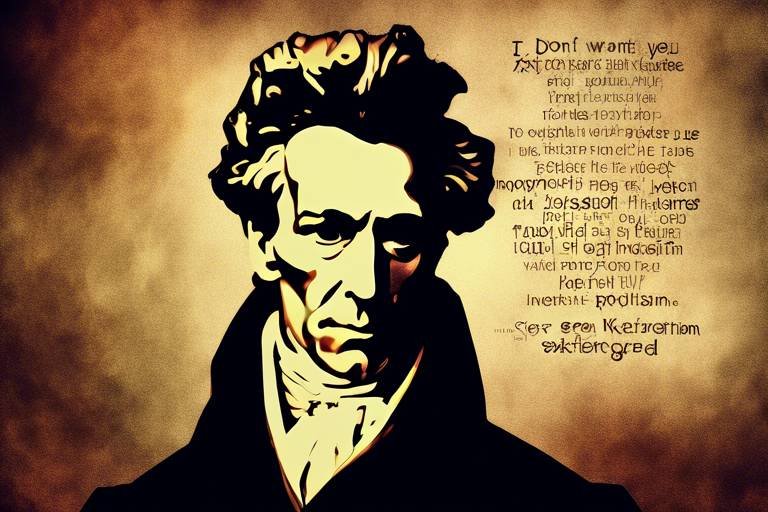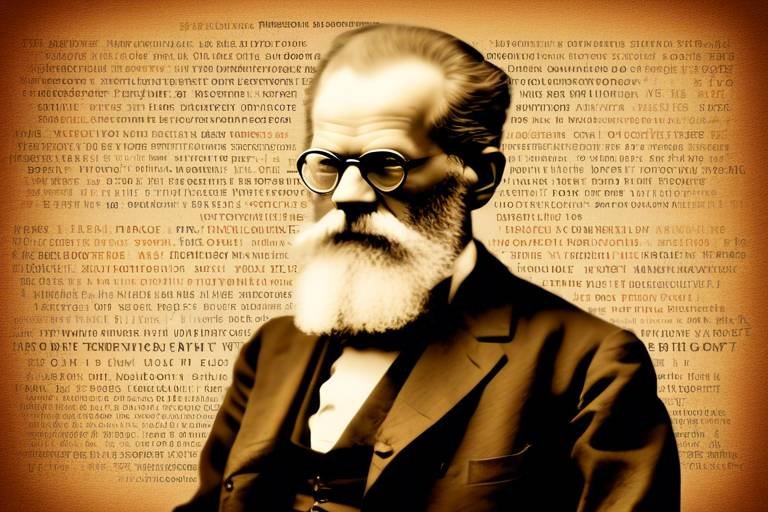Unfolding the Inspirational Philosophy of Mahatma Gandhi
Mahatma Gandhi, a name that resonates with peace and justice, is not just a historical figure; he is a beacon of hope and inspiration for many around the globe. His philosophy, rooted in the principles of non-violence, truth, and self-discipline, continues to echo in the hearts of individuals and movements striving for change. Imagine a world where conflicts are resolved through understanding rather than aggression; this is the essence of Gandhi's teachings. His approach was revolutionary, yet profoundly simple, making it accessible to everyone, regardless of their background or beliefs.
Gandhi's life was a testament to the power of peaceful resistance. He believed that true strength lies not in the ability to inflict pain but in the courage to endure it. This philosophy is especially poignant in today's world, where violence often seems to be the first resort in times of conflict. Gandhi's legacy challenges us to rethink our responses to injustice and to consider the profound impact of peaceful protest. How often do we find ourselves caught in cycles of anger and retaliation? Gandhi invites us to break that cycle and embrace a path of compassion and understanding.
Central to Gandhi's philosophy is the idea of Ahimsa, or non-violence. This principle is not merely the absence of violence but a proactive stance that promotes love and respect for all living beings. By adopting non-violence, individuals not only resist oppression but also cultivate a sense of inner peace. This approach has inspired countless movements across the world, from the Civil Rights Movement in the United States to the anti-apartheid struggle in South Africa. Gandhi's teachings remind us that we can challenge systems of oppression without compromising our ethical standards.
Moreover, Gandhi emphasized the importance of truth, encapsulated in the concept of Satya. For him, truth was a guiding light, illuminating the path towards justice and integrity. He believed that honesty in our personal lives and societal dealings fosters trust and builds stronger communities. In a world often marred by deception and corruption, Gandhi's call to uphold truth is more relevant than ever. Are we willing to be truthful in our actions and words, even when it's inconvenient? This is the challenge Gandhi presents to us.
As we delve deeper into Gandhi's teachings, we uncover the transformative concept of Satyagraha, or "truth force." This method of non-violent resistance empowers individuals to confront injustice with moral conviction. It is not just about resisting oppression but doing so in a way that respects the humanity of all involved. Gandhi's application of Satyagraha during pivotal moments in history, such as the Salt March, is a testament to its effectiveness. By mobilizing masses without resorting to violence, he showcased the strength of collective action grounded in ethical principles.
Today, Satyagraha serves as a model for contemporary social movements, inspiring activists worldwide to pursue justice through peaceful means. Whether it's climate activism or social justice campaigns, the essence of Gandhi's philosophy continues to guide those who seek change. It reinforces the idea that peaceful change is not only possible but necessary for sustainable progress.
In addition to non-violence and truth, Gandhi championed the values of self-discipline and simplicity. He believed that personal integrity and restraint were essential for both individual growth and societal improvement. By leading a simple life, free from excess and materialism, Gandhi exemplified how we can focus on what truly matters: our relationships with others and our contributions to society. In a fast-paced world that often glorifies consumerism, his teachings encourage us to pause, reflect, and prioritize our values.
Furthermore, Gandhi viewed education as a vital tool for empowerment and social change. His philosophy of Nai Talim, or "New Education," promoted an inclusive approach that emphasized moral and practical learning over rote memorization. This innovative educational model aimed to develop well-rounded individuals who could contribute positively to society. In a world where education often focuses solely on academic achievement, Gandhi's vision invites us to consider how we can cultivate character and community through learning.
Finally, Gandhi believed in the power of community and collective action. He understood that real change happens when individuals unite for a common purpose. By advocating for grassroots movements, he fostered solidarity and cooperation among diverse groups. This collective spirit is essential in today's interconnected world, where challenges such as climate change and social injustice require collaborative efforts. Are we ready to come together as a community and work towards a brighter future?
- What is the essence of Gandhi's philosophy? Gandhi's philosophy centers around non-violence, truth, and self-discipline, advocating for peaceful resistance and moral integrity.
- How did Gandhi's teachings influence modern movements? His principles of Satyagraha and non-violence have inspired numerous global movements, emphasizing the power of peaceful protest.
- What role does education play in Gandhi's philosophy? Education is seen as a tool for empowerment, focusing on moral values and practical skills to develop well-rounded individuals.
- Why is community important in Gandhi's teachings? Gandhi believed that collective action and solidarity are crucial for achieving social change and fostering a sense of belonging.

The Principle of Non-Violence
Mahatma Gandhi's unwavering commitment to non-violence, or Ahimsa, stands as a beacon of hope and a guiding principle for countless individuals and movements around the globe. This philosophy is not merely a passive stance against violence; rather, it is an active and powerful method of resistance that seeks to bring about change through peaceful means. Imagine standing firm against a storm, refusing to yield, yet not striking back. This is the essence of Gandhi's approach—using the strength of moral conviction to confront oppression without causing harm.
At its core, non-violence is about more than just avoiding physical confrontation; it embodies a profound respect for all living beings. It challenges us to consider the impact of our actions and words on others, urging us to choose compassion over aggression. Gandhi believed that true strength lies in the ability to maintain one's principles, even in the face of adversity. He famously stated, "Non-violence is the greatest force at the disposal of mankind." This assertion highlights the transformative power of non-violent action, suggesting that it can dismantle even the most entrenched systems of injustice.
Gandhi's philosophy of non-violence was not just theoretical; he put it into practice during pivotal moments in history. For instance, during the Salt March in 1930, he led thousands of Indians to the Arabian Sea to protest the British salt tax. This act of civil disobedience was a brilliant demonstration of non-violent resistance, where participants faced brutal repression yet remained steadfast in their commitment to peace. The Salt March became a symbol of the struggle for independence, illustrating how non-violence could mobilize masses and challenge colonial power effectively.
However, the principle of non-violence goes beyond political movements; it can also be applied in our daily lives. Whether in personal relationships or community interactions, choosing non-violence fosters an environment of respect and understanding. It encourages dialogue over conflict, promoting a culture where differences can be resolved without resorting to hostility. Think about it: how often do we find ourselves caught in arguments that escalate unnecessarily? By embracing non-violence, we can learn to navigate disagreements with grace and empathy.
In today's world, where violence seems to be a prevalent response to conflict, Gandhi's teachings resonate more than ever. Social movements across the globe, from the civil rights movement in the United States to contemporary protests for climate justice, have drawn inspiration from his philosophy. Activists continue to advocate for change through peaceful means, demonstrating that non-violence is not a sign of weakness but a profound expression of strength and resilience.
In summary, the principle of non-violence is a multifaceted philosophy that encourages us to confront injustice with courage while maintaining respect for all. It invites us to reflect on our actions and their consequences, urging us to choose paths that uplift rather than harm. As we navigate our own lives and challenges, let us remember Gandhi's powerful legacy and strive to embody the essence of non-violence in our daily interactions.

The Importance of Truth
The concept of truth, or Satya, was not just a mere philosophical idea for Mahatma Gandhi; it was the very foundation upon which he built his life and activism. Gandhi believed that truth is the ultimate reality, a guiding principle that shapes our actions and interactions. Imagine trying to build a house without a solid foundation; it would crumble under pressure. Similarly, without truth, our relationships and societies risk falling apart. Gandhi's commitment to truth was profound, as he understood that honesty fosters trust, and trust is essential for any community to thrive.
In Gandhi's view, truth was not simply about telling the truth in conversations. It encompassed a broader spectrum of integrity and authenticity in all aspects of life. He argued that when individuals embody truthfulness, they not only uplift themselves but also inspire those around them. This ripple effect can lead to a more just and harmonious society. For Gandhi, truth was a powerful force that could dismantle injustices and promote social equity. He famously stated, "An ounce of practice is worth more than tons of preaching," emphasizing that living truthfully was far more impactful than merely discussing it.
One of the most compelling aspects of Gandhi's philosophy on truth is the idea that it is inherently linked to non-violence. He believed that when one operates from a place of truth, they are less likely to harm others, whether physically or emotionally. This connection between truth and non-violence reveals the depth of Gandhi's understanding of human relationships. When individuals commit to honesty, they create an environment where dialogue and understanding can flourish, rather than conflict and hostility.
Gandhi's teachings on truth extend beyond personal conduct; they encompass societal dealings as well. In a world rife with corruption and deception, he urged individuals to challenge these norms. By standing firm in their truth, people could foster a culture of transparency and accountability. This principle resonates deeply in today's society, where misinformation can lead to chaos. Gandhi's advocacy for truth reminds us that, in our quest for justice and equality, we must always prioritize honesty.
To illustrate the transformative power of truth, consider the following key aspects of Gandhi's philosophy:
- Integrity in Actions: Gandhi believed that one's actions should reflect their words. This alignment is crucial for building credibility and trust.
- Collective Truth: He emphasized the importance of collective truth, where communities come together to uphold honesty and justice.
- Empowerment through Truth: Truth empowers individuals to stand against oppression and injustice, leading to societal change.
In conclusion, truth is not merely a principle for Gandhi; it is a way of life that has the potential to transform individuals and societies. By embracing truth, we can create a world where trust, justice, and peace prevail. As we navigate our own lives, let us remember Gandhi's wisdom and strive to uphold truth in every interaction, big or small. After all, when we choose truth, we choose a path that leads to genuine understanding and lasting change.
- What is the significance of truth in Gandhi's philosophy? Truth is the foundation of Gandhi's philosophy, promoting honesty and integrity in personal and societal interactions.
- How does Gandhi connect truth to non-violence? Gandhi believed that operating from a place of truth reduces the likelihood of harm, fostering dialogue and understanding instead of conflict.
- Can truth lead to social change? Yes, by standing firm in truth, individuals can challenge injustices and promote transparency, leading to societal transformation.

Satyagraha: The Force of Truth
Satyagraha, a term that resonates with the very essence of Gandhi's philosophy, translates to "truth force." This concept is not merely a tactic; it is a profound approach to confronting injustice and oppression. Imagine standing firmly in your beliefs, not with fists raised or weapons drawn, but with the unwavering strength of your convictions. This is the heart of Satyagraha. Gandhi believed that true power lies in the ability to resist evil without resorting to violence. He argued that non-violent resistance could bring about change more effectively than any act of aggression.
The essence of Satyagraha is rooted in the belief that individuals can harness the power of truth to challenge and change oppressive systems. It encourages a deep-seated commitment to ethical principles, allowing individuals to confront wrongs while maintaining their integrity. This method of resistance is not passive; it requires immense courage and a steadfast resolve to stand up against injustice. Gandhi's vision was clear: to transform the oppressor through love and understanding rather than hatred and violence.
Throughout history, Satyagraha has manifested in various forms, often igniting movements that have changed the course of nations. It is a reminder that the strength of a movement is not only in numbers but also in the moral clarity of its cause. This is evident in the way Satyagraha was employed during the Indian independence movement, where people from all walks of life united in their quest for freedom. The Salt March of 1930 is a prime example, showcasing how a simple act of defiance against unjust laws could galvanize a nation.
Today, the principles of Satyagraha continue to inspire activists and movements around the globe. In an age where violence seems to dominate headlines, the teachings of Gandhi remind us that peaceful resistance is not just a viable option; it is often the most powerful one. From civil rights movements in the United States to anti-apartheid struggles in South Africa, Satyagraha serves as a beacon of hope for those seeking justice. It emphasizes that even in the face of overwhelming odds, individuals can make a difference through their commitment to truth and non-violence.
In essence, Satyagraha is more than just a method; it is a philosophy that empowers individuals to act with conviction. It invites each of us to reflect on our own values and the ways we can contribute to a more just world. By embracing the force of truth, we not only honor Gandhi's legacy but also pave the way for future generations to fight for justice with compassion and integrity.

truth force,
This article explores the core principles of Mahatma Gandhi's philosophy, including non-violence, truth, and self-discipline, and how they continue to inspire individuals and movements around the world today.
Gandhi's commitment to non-violence, or Ahimsa, was central to his philosophy, advocating for peaceful resistance as a means to achieve social and political change without causing harm to others.
Truth, or Satya, was another cornerstone of Gandhi's teachings, emphasizing the necessity of honesty and integrity in both personal conduct and societal dealings to foster trust and justice.
Satyagraha, meaning truth force, is Gandhi's method of non-violent resistance that empowers individuals to confront injustice through peaceful means. This concept is not just about standing firm in one’s beliefs; it embodies the idea that truth has an intrinsic power that can drive social change. When individuals unite under the banner of truth, they create a force that is both moral and compelling, capable of moving mountains of injustice.
Gandhi believed that by adhering to truth, one could achieve a higher moral ground that not only inspires others but also instills a sense of purpose and direction. The beauty of Satyagraha lies in its ability to transform personal conviction into collective action, turning ordinary individuals into powerful agents of change. This method emphasizes that the path to justice does not have to be paved with violence; instead, it can be illuminated by the unwavering light of truth.
Throughout history, Gandhi applied Satyagraha in various movements, most notably during the Salt March in 1930. This significant event showcased the effectiveness of non-violent protest against oppressive laws. By marching to the sea to make salt, Gandhi mobilized thousands to join him in a peaceful act of defiance, illustrating how a steadfast commitment to truth can rally people together against injustice.
Today, Satyagraha serves as a model for contemporary social movements. Activists around the globe draw inspiration from Gandhi’s principles, using non-violent methods to advocate for change. Whether it’s fighting for civil rights, environmental justice, or political reform, the essence of Satyagraha remains relevant. It reinforces the idea that peaceful change is possible, urging us to confront challenges with courage and conviction rather than aggression.
Gandhi advocated for self-discipline and a simple lifestyle, believing that personal integrity and restraint were essential for both individual growth and societal improvement.
Gandhi viewed education as a vital tool for empowerment and social change, promoting an inclusive approach that emphasized moral and practical learning over rote memorization.
Nai Talim, or New Education, was Gandhi's educational philosophy, integrating vocational training with moral values, aiming to develop well-rounded individuals who contribute positively to society.
Gandhi believed in the power of community and collective action, advocating for grassroots movements that unite individuals in pursuit of common goals, fostering solidarity and cooperation.
- What is Satyagraha? Satyagraha is a method of non-violent resistance developed by Mahatma Gandhi, emphasizing the power of truth to bring about social change.
- How does Satyagraha differ from other forms of protest? Unlike violent protests, Satyagraha relies on peaceful methods and moral conviction to confront injustice.
- Can Satyagraha be applied today? Yes, Satyagraha is relevant in contemporary social movements, inspiring activists to pursue justice through non-violent means.

is Gandhi's method of non-violent resistance, which empowers individuals to confront injustice through peaceful means, showcasing the strength of moral conviction.
This article explores the core principles of Mahatma Gandhi's philosophy, including non-violence, truth, and self-discipline, and how they continue to inspire individuals and movements around the world today.
Gandhi's commitment to non-violence, or Ahimsa, was central to his philosophy, advocating for peaceful resistance as a means to achieve social and political change without causing harm to others.
Truth, or Satya, was another cornerstone of Gandhi's teachings, emphasizing the necessity of honesty and integrity in both personal conduct and societal dealings to foster trust and justice.
Satyagraha is Gandhi's method of non-violent resistance, which empowers individuals to confront injustice through peaceful means, showcasing the strength of moral conviction. This powerful concept is not just a strategy; it is a way of life that urges individuals to stand firm in their beliefs without resorting to violence. Imagine standing up against a giant, yet instead of weapons, you wield the truth. Satyagraha encourages people to harness their inner strength and moral compass to fight against oppression and inequality. It transforms the act of resistance into a profound statement of integrity and courage.
The essence of Satyagraha lies in the belief that moral authority can triumph over physical force. Gandhi believed that when individuals unite under the banner of truth and non-violence, they create a formidable force capable of instigating change. This approach not only seeks justice but also aims to convert the oppressor through understanding and compassion, rather than hatred. In a world often riddled with conflict, Satyagraha serves as a beacon of hope, illustrating that peaceful methods can lead to powerful outcomes.
Gandhi's application of Satyagraha in various movements, such as the Salt March, illustrates its effectiveness in mobilizing masses against oppression while maintaining ethical standards. The Salt March of 1930 was a pivotal moment that showcased the power of collective non-violent action. Gandhi led thousands on a 240-mile march to the Arabian Sea to produce salt, defying British laws. This act not only sparked widespread civil disobedience but also highlighted the injustice of colonial rule, demonstrating the impact of Satyagraha in real-world scenarios.
Today, Satyagraha serves as a model for contemporary social movements, inspiring activists worldwide to pursue justice through non-violent means, reinforcing the idea that peaceful change is possible. From the civil rights movement in the United States to various environmental protests, the principles of Satyagraha resonate deeply. Activists recognize that the fight for justice does not require violence; instead, it thrives on the strength of unity and unwavering commitment to the truth.
Gandhi advocated for self-discipline and a simple lifestyle, believing that personal integrity and restraint were essential for both individual growth and societal improvement.
Gandhi viewed education as a vital tool for empowerment and social change, promoting an inclusive approach that emphasized moral and practical learning over rote memorization.
Nai Talim, or New Education, was Gandhi's educational philosophy, integrating vocational training with moral values, aiming to develop well-rounded individuals who contribute positively to society.
Gandhi believed in the power of community and collective action, advocating for grassroots movements that unite individuals in pursuit of common goals, fostering solidarity and cooperation.
- What does Satyagraha mean? Satyagraha translates to "truth force," representing Gandhi's method of non-violent resistance against injustice.
- How did Gandhi use Satyagraha in his movements? Gandhi employed Satyagraha in various campaigns, most notably the Salt March, to mobilize people against oppressive laws through peaceful means.
- Can Satyagraha be applied today? Yes, Satyagraha remains relevant today, inspiring modern movements advocating for social justice, human rights, and environmental protection through non-violent means.
- What is the significance of Ahimsa in Gandhi's philosophy? Ahimsa, or non-violence, is crucial in Gandhi's philosophy, promoting the idea that one can resist oppression without causing harm to others.

Historical Examples of Satyagraha
Mahatma Gandhi's philosophy of Satyagraha, which translates to "truth force," is not just a theoretical concept but a practical approach that has been applied in various historical contexts. One of the most significant examples of Satyagraha was the **Salt March** in 1930. This event was a pivotal moment in the Indian independence movement, where Gandhi led thousands of followers on a 240-mile march to the Arabian Sea to produce salt, defying British laws that imposed a salt tax. This act of civil disobedience was not only a challenge to colonial authority but also a demonstration of the power of non-violent protest. The Salt March galvanized the Indian populace, showcasing how collective action rooted in truth and non-violence could challenge oppression.
Another notable instance was the **Champaran Satyagraha** of 1917, where Gandhi intervened on behalf of farmers in Bihar who were being exploited by British planters. The farmers were forced to grow indigo under oppressive conditions, and Gandhi's non-violent resistance brought national attention to their plight. Through peaceful negotiation and mobilization, Gandhi was able to secure significant reforms, illustrating the effectiveness of Satyagraha in addressing social injustices.
Additionally, the **Kheda Satyagraha** in 1918 further exemplifies Gandhi's method. During a severe famine, farmers in Kheda were unable to pay taxes, yet the British government continued to demand them. Gandhi organized a peaceful protest, urging the farmers to refuse payment. This movement not only resulted in tax relief for the farmers but also reinforced the idea that non-violent resistance could yield tangible results against an oppressive regime.
These historical examples of Satyagraha reveal a consistent theme: the ability of individuals united in a common cause to confront injustice without resorting to violence. Gandhi’s approach emphasized moral integrity and the strength of collective action. Even today, the principles of Satyagraha resonate globally, inspiring movements for civil rights and social justice. For instance, Martin Luther King Jr. drew heavily on Gandhi's teachings during the American civil rights movement, proving that the legacy of Satyagraha transcends borders and continues to inspire generations.
In essence, the historical applications of Satyagraha illustrate its profound impact on social change. They remind us that **non-violence is not a passive stance**, but a powerful tool for achieving justice and equality. The courage displayed by those who participated in these movements serves as a beacon of hope, encouraging us to believe in the possibility of peaceful transformation in our own lives and communities.
- What is Satyagraha? Satyagraha is a philosophy developed by Mahatma Gandhi that emphasizes non-violent resistance and the power of truth in confronting injustice.
- How did Satyagraha influence other movements? Satyagraha inspired numerous global movements, including the American civil rights movement led by Martin Luther King Jr., showcasing its universal appeal.
- What are some key principles of Satyagraha? The key principles include non-violence (Ahimsa), truth (Satya), and the importance of moral integrity in the pursuit of justice.
- Can Satyagraha be applied in modern contexts? Yes, Satyagraha remains relevant today, encouraging individuals and groups to advocate for social change through peaceful means.

Modern Relevance of Satyagraha
Satyagraha, the profound philosophy of non-violent resistance pioneered by Mahatma Gandhi, continues to resonate deeply in our contemporary world. In an era where conflicts often escalate into violence, the principles of Satyagraha remind us that peaceful protest and moral conviction can be powerful tools for change. This approach isn't just a relic of the past; it's a living, breathing method that inspires countless movements around the globe today. Can you imagine a world where peaceful dialogue replaces violent confrontation? That's the essence of Satyagraha.
In recent years, we've seen the resurgence of Satyagraha-like movements, showcasing how its core tenets can be applied to modern struggles for justice and equality. For instance, movements advocating for civil rights, environmental justice, and social equity have drawn upon Gandhi's teachings. Activists today are harnessing the spirit of Satyagraha, utilizing strategies such as:
- Peaceful demonstrations: Organizing marches and sit-ins to express dissent without resorting to violence.
- Grassroots mobilization: Building communities that unite diverse groups in pursuit of common goals.
- Digital activism: Using social media platforms to spread awareness and gather support for various causes.
One of the most striking examples of Satyagraha's relevance is seen in the global climate movement. Activists around the world are adopting non-violent methods to advocate for urgent action against climate change. They understand that the fight for a sustainable planet requires not just awareness but also a commitment to ethical practices and peaceful advocacy. This approach mirrors Gandhi's belief that the means must align with the end; if we seek a peaceful world, we must act peacefully.
Moreover, Satyagraha empowers individuals to confront injustice in their daily lives. It encourages personal responsibility and resilience, reminding us that everyone has a role to play in the quest for justice. Whether it's standing up against workplace discrimination or advocating for marginalized communities, the principles of Satyagraha can guide our actions. It's about being the change we wish to see, and that starts with each one of us.
In conclusion, the modern relevance of Satyagraha is undeniable. Its principles not only provide a framework for peaceful protest but also inspire a collective consciousness that values integrity, justice, and community. As we navigate the complexities of our world, embracing Satyagraha can lead us towards a future where dialogue triumphs over discord, and love prevails over hatred. Isn't that a vision worth striving for?
- What is Satyagraha? Satyagraha is a philosophy of non-violent resistance developed by Mahatma Gandhi, emphasizing the power of truth and moral integrity.
- How can Satyagraha be applied today? Satyagraha can be applied through peaceful protests, community organizing, and personal acts of integrity in the face of injustice.
- Why is non-violence important in activism? Non-violence fosters dialogue and understanding, reducing the likelihood of escalation into violence and allowing for more sustainable change.
- Can Satyagraha be effective in addressing global issues? Yes, many contemporary movements, such as climate action and civil rights, utilize Satyagraha principles to advocate for change.

Self-Discipline and Simplicity
When we think about self-discipline and simplicity, it’s easy to get lost in the hustle and bustle of modern life. But Gandhi had a unique perspective on these principles that is still relevant today. He believed that self-discipline was not just about strict rules or harsh restrictions; rather, it was about cultivating an inner strength that allows us to make conscious choices in our lives. Imagine trying to build a sturdy house without a solid foundation—self-discipline serves as that foundation, enabling us to withstand the storms of life.
Gandhi’s emphasis on simplicity was equally profound. He often advocated for a lifestyle that stripped away excess and focused on what truly mattered. In a world overflowing with materialism, this message resonates louder than ever. Gandhi's approach encouraged individuals to reflect on their needs versus wants. He famously lived a life of minimalism, wearing simple clothes and eating basic foods, which he believed brought clarity and purpose to his life. By embracing simplicity, we can free ourselves from the clutter that distracts us from our true goals.
To put it into perspective, consider these key aspects of self-discipline and simplicity:
- Clarity of Purpose: Self-discipline helps us define our goals clearly, while simplicity allows us to focus on them without unnecessary distractions.
- Inner Peace: A disciplined mind fosters tranquility, and a simple life promotes contentment.
- Empowerment: Both principles empower us to take control of our lives, leading to greater satisfaction and achievement.
Gandhi's philosophy teaches us that self-discipline and simplicity are intertwined. When we practice self-discipline, we naturally gravitate towards a simpler way of living. It's like cleaning out a cluttered closet; once you start organizing and removing what you don’t need, you realize how much space you have for what truly matters. This practice can lead to a more fulfilling life, where we prioritize our values and intentions over fleeting desires.
In a world that often encourages excess and distraction, Gandhi's teachings remind us of the power of restraint and the beauty of a simple life. By embracing these principles, we can cultivate a lifestyle that not only enhances our personal growth but also contributes positively to our communities. After all, when we simplify our lives, we open up space for meaningful connections and impactful actions.
- What is self-discipline? Self-discipline refers to the ability to control one’s emotions, behaviors, and desires in the face of external demands, enabling individuals to pursue their goals consistently.
- How can I practice simplicity in my daily life? You can practice simplicity by decluttering your space, prioritizing your time, and focusing on experiences rather than material possessions.
- Why are self-discipline and simplicity important? Both principles help create a balanced life, allowing individuals to focus on their true priorities and achieve greater satisfaction and peace.

The Role of Education in Gandhi's Philosophy
Education played a pivotal role in Mahatma Gandhi's vision for a just society. He believed that education was not merely about acquiring knowledge but rather a comprehensive process of personal development that encompasses moral, practical, and intellectual growth. Gandhi's approach to education was deeply rooted in his philosophy of empowerment, viewing it as a fundamental tool for social change. He famously stated, "Be the change that you wish to see in the world," indicating that education should inspire individuals to take action and contribute positively to their communities.
One of the key aspects of Gandhi's educational philosophy was the emphasis on moral values. He argued that education should not only focus on academic subjects but also instill a sense of ethics and responsibility in students. This holistic approach aimed to create individuals who are not only knowledgeable but also compassionate and socially aware. In Gandhi's view, education should nurture the mind, body, and spirit, fostering a sense of integrity and purpose.
Gandhi proposed the concept of Nai Talim, or "New Education," which integrated vocational training with moral values. This innovative educational model was designed to equip students with practical skills while also emphasizing the importance of ethical conduct. By combining hands-on learning with moral teachings, Gandhi aimed to create well-rounded individuals who could contribute to society in meaningful ways. He believed that education should empower individuals to be self-sufficient and socially responsible, ultimately leading to a more equitable society.
| Key Elements of Nai Talim | Description |
|---|---|
| Vocational Training | Emphasizing practical skills that prepare students for various trades and professions. |
| Moral Education | Incorporating lessons on ethics, integrity, and social responsibility into the curriculum. |
| Community Engagement | Encouraging students to participate in community service and social improvement initiatives. |
| Holistic Development | Fostering the growth of the mind, body, and spirit in a balanced manner. |
Moreover, Gandhi's vision extended beyond formal education. He believed in the power of community and collective action as crucial components of education. He advocated for grassroots movements that unite individuals in pursuit of common goals, fostering solidarity and cooperation. By promoting the idea that education should be a community effort, Gandhi sought to empower marginalized groups and create a more inclusive society.
In today's world, Gandhi's educational philosophy remains relevant as we grapple with issues of inequality and social justice. His emphasis on moral education and community engagement serves as a guiding light for educators and activists alike. By adopting Gandhi's principles, we can strive to create educational systems that not only impart knowledge but also cultivate responsible, empathetic citizens who are equipped to tackle the challenges of our time.
- What is Nai Talim? Nai Talim, or "New Education," is Gandhi's educational philosophy that integrates vocational training with moral values, aiming to develop well-rounded individuals.
- How did Gandhi view the role of education? Gandhi viewed education as a vital tool for empowerment and social change, emphasizing moral values and practical learning over rote memorization.
- Why is community engagement important in education according to Gandhi? Gandhi believed that community engagement fosters solidarity and cooperation, empowering individuals to work together towards common goals.

Nai Talim: New Education
Nai Talim, which translates to New Education, is a revolutionary educational philosophy proposed by Mahatma Gandhi that redefined the conventional approach to learning. Rather than focusing solely on academic achievement, Nai Talim emphasizes the holistic development of individuals. It aims to cultivate not just intellectual capabilities but also moral values, practical skills, and a sense of social responsibility. Imagine education as a garden where knowledge, ethics, and skills grow together, nurturing well-rounded individuals who can contribute positively to society.
At the heart of Nai Talim is the belief that education should be relevant to the real world. Gandhi envisioned an educational system that integrates vocational training with academic learning, allowing students to apply their knowledge in practical settings. This approach not only equips learners with essential skills but also fosters a sense of dignity in labor. For instance, students might engage in activities like farming, weaving, or carpentry, which not only teach them valuable trades but also instill a respect for manual work.
Furthermore, Nai Talim advocates for an inclusive and participatory learning environment. Gandhi believed that education should be accessible to all, regardless of their background. By emphasizing cooperative learning, students learn the importance of collaboration and community, echoing Gandhi's broader philosophy of collective action. In this way, education becomes a tool for social change, empowering individuals to uplift themselves and their communities.
To illustrate the key components of Nai Talim, consider the following table:
| Key Component | Description |
|---|---|
| Holistic Development | Focus on intellectual, moral, and practical growth. |
| Vocational Training | Integration of skills with academic subjects. |
| Inclusivity | Education accessible to all, promoting equality. |
| Community Engagement | Encouragement of collective learning and cooperation. |
In essence, Nai Talim is not merely about acquiring knowledge; it’s about transforming individuals into responsible citizens who are equipped to face the challenges of the world. It encourages students to think critically, act ethically, and engage with their communities. By fostering a sense of purpose and responsibility, Gandhi's vision for education remains profoundly relevant in today's society. As we navigate the complexities of modern life, the principles of Nai Talim remind us that education should not just be about personal success, but about making a positive impact on the world around us.
- What is Nai Talim? Nai Talim, or New Education, is an educational philosophy proposed by Mahatma Gandhi emphasizing holistic development, vocational training, and community engagement.
- How does Nai Talim differ from traditional education? Unlike traditional education, which often focuses on rote memorization, Nai Talim integrates moral values and practical skills, fostering a well-rounded individual.
- Why is vocational training important in Nai Talim? Vocational training provides students with essential skills and promotes respect for labor, preparing them for real-world challenges.
- How can Nai Talim impact society today? By promoting inclusivity and community engagement, Nai Talim empowers individuals to contribute positively to their communities and drive social change.

New Education,
Gandhi's commitment to non-violence, or Ahimsa, was central to his philosophy, advocating for peaceful resistance as a means to achieve social and political change without causing harm to others.
Truth, or Satya, was another cornerstone of Gandhi's teachings, emphasizing the necessity of honesty and integrity in both personal conduct and societal dealings to foster trust and justice.
Satyagraha, meaning truth force, is Gandhi's method of non-violent resistance, which empowers individuals to confront injustice through peaceful means, showcasing the strength of moral conviction.
Gandhi's application of Satyagraha in various movements, such as the Salt March, illustrates its effectiveness in mobilizing masses against oppression while maintaining ethical standards.
Today, Satyagraha serves as a model for contemporary social movements, inspiring activists worldwide to pursue justice through non-violent means, reinforcing the idea that peaceful change is possible.
Gandhi advocated for self-discipline and a simple lifestyle, believing that personal integrity and restraint were essential for both individual growth and societal improvement.
Gandhi viewed education as a vital tool for empowerment and social change, promoting an inclusive approach that emphasized moral and practical learning over rote memorization.
Nai Talim, or New Education, was Gandhi's innovative educational philosophy that sought to revolutionize the way knowledge was imparted. Unlike traditional systems that focused solely on academic achievement, Nai Talim aimed to nurture a holistic development of individuals. It emphasized the importance of integrating vocational training with moral values, creating a system where students could learn practical skills alongside ethical principles. This approach was rooted in the belief that education should not only prepare students for jobs but also instill a sense of responsibility and community.
In the Nai Talim framework, education was seen as a means to cultivate not just intellectual capabilities but also emotional and social skills. Gandhi believed that true education should empower individuals to contribute positively to society. The core tenets of Nai Talim included:
- Experiential Learning: Students engaged in hands-on activities, allowing them to learn by doing, which made the educational experience more engaging and relevant.
- Moral Development: Emphasizing ethics, students were taught the importance of honesty, integrity, and respect for all, fostering a well-rounded character.
- Community Engagement: Education was linked to community service, encouraging students to participate in local initiatives and understand their role in society.
This philosophy was revolutionary for its time, as it challenged the conventional norms of education that prioritized memorization and examination results. By focusing on the development of the whole person, Nai Talim aimed to create not just skilled workers, but responsible citizens committed to the welfare of their communities.
As we look at the educational landscape today, the principles of Nai Talim resonate strongly. The push for project-based learning, social-emotional learning, and community service in schools reflects Gandhi's vision of an education system that prepares individuals to face the challenges of modern society while remaining grounded in ethical values.
Gandhi believed in the power of community and collective action, advocating for grassroots movements that unite individuals in pursuit of common goals, fostering solidarity and cooperation.
- What is the essence of Gandhi's philosophy?
Gandhi's philosophy centers around non-violence, truth, and self-discipline, advocating for peaceful means of achieving social and political change. - How does Nai Talim differ from traditional education?
Nai Talim emphasizes practical skills and moral values over rote memorization, aiming for holistic development of individuals. - Can Gandhi's principles be applied today?
Absolutely! Gandhi's teachings on non-violence and truth continue to inspire social movements and individuals striving for justice globally.

was Gandhi's educational philosophy, integrating vocational training with moral values, aiming to develop well-rounded individuals who contribute positively to society.
This article explores the core principles of Mahatma Gandhi's philosophy, including non-violence, truth, and self-discipline, and how they continue to inspire individuals and movements around the world today.
Gandhi's commitment to non-violence, or Ahimsa, was central to his philosophy, advocating for peaceful resistance as a means to achieve social and political change without causing harm to others.
Truth, or Satya, was another cornerstone of Gandhi's teachings, emphasizing the necessity of honesty and integrity in both personal conduct and societal dealings to foster trust and justice.
Satyagraha, meaning truth force, is Gandhi's method of non-violent resistance, which empowers individuals to confront injustice through peaceful means, showcasing the strength of moral conviction.
Gandhi's application of Satyagraha in various movements, such as the Salt March, illustrates its effectiveness in mobilizing masses against oppression while maintaining ethical standards.
Today, Satyagraha serves as a model for contemporary social movements, inspiring activists worldwide to pursue justice through non-violent means, reinforcing the idea that peaceful change is possible.
Gandhi advocated for self-discipline and a simple lifestyle, believing that personal integrity and restraint were essential for both individual growth and societal improvement.
Gandhi viewed education as a vital tool for empowerment and social change, promoting an inclusive approach that emphasized moral and practical learning over rote memorization.
Nai Talim, or New Education, was Gandhi's educational philosophy, integrating vocational training with moral values, aiming to develop well-rounded individuals who contribute positively to society. This approach wasn't just about acquiring knowledge; it was about fostering a sense of responsibility and ethical conduct among students. Gandhi believed that education should not merely prepare individuals for jobs but also shape their character and instill a sense of duty towards society.
In practice, Nai Talim emphasized hands-on learning, where students engaged in various trades and crafts while simultaneously learning moral values. This dual approach ensured that students developed practical skills along with a strong ethical foundation. For instance, a student learning carpentry would also learn the importance of honesty and respect for their craft, understanding that their work impacts the community. By intertwining vocational training with moral education, Gandhi aimed to cultivate individuals who were not only skilled but also conscious of their role in society.
Gandhi believed in the power of community and collective action, advocating for grassroots movements that unite individuals in pursuit of common goals, fostering solidarity and cooperation.
- What is the essence of Gandhi's philosophy?
Gandhi's philosophy revolves around non-violence, truth, and self-discipline, which he believed were essential for personal and societal transformation. - How does Satyagraha work?
Satyagraha is a method of non-violent resistance that empowers individuals to confront injustice through peaceful means, relying on the strength of moral conviction. - What is Nai Talim?
Nai Talim is Gandhi's educational philosophy that integrates vocational training with moral values, aiming to develop individuals who contribute positively to society. - How relevant is Gandhi's philosophy today?
Gandhi's philosophy remains highly relevant, inspiring contemporary social movements to pursue justice through non-violent means and ethical practices.

Community and Collective Action
When we think about , it’s hard not to draw parallels with the vibrant tapestry of life itself. Just as each thread contributes to the overall design, so do individuals come together to form a community, united by shared goals and aspirations. Mahatma Gandhi recognized this profound truth and emphasized the importance of collective efforts in bringing about social change. He believed that when people unite, their voices become louder, and their impact more significant. This idea is not just a lofty concept; it's a practical approach that has driven movements throughout history.
Gandhi's vision of community was rooted in the belief that every individual has a role to play. He often stated that “In a gentle way, you can shake the world.” This shaking of the world is not a solitary endeavor; it requires the strength of many. By fostering grassroots movements, Gandhi encouraged individuals to come together, share their experiences, and collaborate towards common goals. This collective action not only amplifies their impact but also builds a sense of solidarity and trust among community members.
One of the remarkable aspects of Gandhi's approach was his emphasis on inclusivity. He believed that everyone, regardless of their background, should participate in the quest for justice and equality. This is particularly relevant in today's context, where social movements are often ignited by the collective efforts of diverse groups. For instance, the recent global movements advocating for climate justice and racial equality have demonstrated how powerful community engagement can be when people from various walks of life come together to demand change.
To illustrate the effectiveness of community action, let’s take a closer look at some of the key principles that underpin this philosophy:
- Empowerment: Collective action empowers individuals by giving them a platform to voice their concerns and take part in decision-making.
- Collaboration: Working together fosters a sense of unity and shared purpose, which can lead to more innovative solutions to social issues.
- Accountability: When communities band together, they hold each other accountable, ensuring that commitments are met and actions are aligned with collective goals.
Gandhi’s legacy in community and collective action is not just historical; it continues to resonate today. Activists around the world draw inspiration from his methods, employing non-violent strategies in their fight for justice. From local neighborhood initiatives to global movements, the principles of collective action remain vital. It’s about recognizing that together, we can achieve what seems impossible as individuals.
In essence, the spirit of community and collective action is alive and well, echoing Gandhi's belief that true change comes from the ground up. It invites us to reflect on our roles within our communities and challenges us to engage actively. Whether through volunteering, participating in local governance, or joining social movements, each of us has the power to contribute to a larger narrative of change.
- What are some examples of collective action in modern society?
Examples include climate strikes, community organizing for social justice, and local food cooperatives. - How can I get involved in community action?
Start by identifying local organizations that align with your values and volunteer your time or skills. - What role does social media play in collective action?
Social media serves as a powerful tool for organizing, raising awareness, and mobilizing support for various causes.
Frequently Asked Questions
- What is the principle of non-violence in Gandhi's philosophy?
The principle of non-violence, or Ahimsa, is at the heart of Gandhi's teachings. It advocates for peaceful resistance as a powerful means to achieve social and political change without inflicting harm on others. Gandhi believed that true strength lies in the ability to confront injustice without resorting to violence, promoting a culture of peace and understanding.
- How does truth play a role in Gandhi's teachings?
Truth, known as Satya, is another cornerstone of Gandhi's philosophy. He emphasized the importance of honesty and integrity in all aspects of life, both personally and socially. By fostering a commitment to truth, Gandhi believed that individuals could build trust and justice within their communities, paving the way for a more ethical society.
- What is Satyagraha and how does it relate to Gandhi's philosophy?
Satyagraha, which translates to "truth force," is Gandhi's unique method of non-violent resistance. It empowers individuals to confront oppression through peaceful means, showcasing the strength of moral conviction. This approach highlights that one can stand up against injustice without resorting to violence, inspiring countless movements for social change worldwide.
- Can you provide examples of Satyagraha in history?
One notable example of Satyagraha is the Salt March in 1930, where Gandhi led a peaceful protest against British salt taxes in India. This movement galvanized masses and illustrated the effectiveness of non-violent resistance in mobilizing people against oppression, while adhering to ethical principles.
- How is Satyagraha relevant in modern times?
Today, Satyagraha serves as a powerful model for contemporary social movements. Activists across the globe draw inspiration from Gandhi's teachings, advocating for justice and equality through non-violent means. This reinforces the idea that peaceful change is achievable, even in the face of significant challenges.
- What does Gandhi say about self-discipline and simplicity?
Gandhi strongly advocated for self-discipline and a simple lifestyle. He believed that personal integrity and restraint were crucial for individual growth and societal improvement. By embracing simplicity, individuals can focus on what truly matters, fostering a sense of purpose and connection to their communities.
- What role does education play in Gandhi's philosophy?
Gandhi viewed education as a vital tool for empowerment and social change. He promoted an inclusive approach that emphasized moral and practical learning over rote memorization, aiming to cultivate well-rounded individuals who could contribute positively to society.
- What is Nai Talim?
Nai Talim, or "New Education," is Gandhi's educational philosophy that integrates vocational training with moral values. This approach aims to develop individuals who are not only skilled but also possess a strong ethical foundation, enabling them to make meaningful contributions to their communities.
- How did Gandhi view community and collective action?
Gandhi believed in the immense power of community and collective action. He advocated for grassroots movements that unite individuals in pursuit of common goals, fostering solidarity and cooperation. By working together, communities can create lasting change and address social injustices more effectively.



















